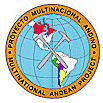
?
|
?MAP NEWS |
| ? |
1997/1998
|
|
 |
? |
Sample Processing? We currently are trying to straighten out several problems with sampling, from couriering the samples to Canada to finding new laboratories for K-Ar analyses. ? K-Ar: The part has arrived at UBC that has been holding up the setup of their laboratory. Hopefully this means within a month to a few months we will have cleared up the backlog of K-Ar dating and be in a position to date new samples. ? Ar-Ar: Mike Villeneuve is planning a young (<5 Ma) sample batch for irradiation in June. Samples need to be in Vancouver before the end of May to have chance of being included in this batch. The next young irradiation will be in late November-early December. If you have young samples, send them as soon as possible and we will forward them to Mike Villeneuve for sample preparation, even if the final results take longer to get. In the early Fall, a batch of Precambrian samples will be sent for irradiation, followed by a batch of Phanerozoic samples. The next young batch will not be irradiated at least until after one Phanerozoic irradiation. ? Major and Trace Element Geochemistry: All samples for major and trace element geochemistry will undergo two crushing procedures, in order to eliminate contamination problems. We have the capabilities for doing all crushing in Vancouver and/or through commercial laboratories. However, if you want to pulverize the samples in country, you will need to still send uncrushed material unless you have both a W-carbide and a soft Fe pulverizer. If you have questions about potential contamination from your pulverizing setup, please feel free to call Ben Edwards at Tel : (604) 666-0528 or Email: [email protected]. ? Lithogeochemistry: (nothing to report) Sample standards: I have obtained a limited quantity of standard material from Peter Friske (GSC Ottawa) that can be used for setting up country standards. We are currently deciding how to distribute the material as we have only a limited quantity. |
| ? | ? |
Verifiable Indicators? We wish to take this opportunity to thank everyone again for their contribution to the Verifiable Indicators' Report last year. We are very pleased to see that there are significant results arising from the MAP Project. As you all know verifiable indicators are concrete evidence that the Project is advancing in the desired direction. It is important to remember that the report on verifiable indicators is ongoing. We need to report to CIDA regularly about the progress of the Project. Please send any information that would be considered a verifiable indicator. Remember that this information should reflect cooperation between participating countries, and institutional enhancement. Following are some guideline questions. ? - Has anyone in your institution involved in MAP given a talk on a topic related to the Project? ? - Has anyone in your institution involved in MAP visited other participant countries and/or discussed any topic related to MAP? ? - Has anyone from another MAP participating country visited your institution and discussed any topic related to MAP? ? - Has anyone on the MAP team attended any courses or conferences? (for example the field log course) and what were the benefits? ? - Are there new mineral claims or mining concessions within the project area ? ? - Are there new land claims within the Project area? ? You can send this information via E-mail or Fax to: Rocio E. Lopez Fax: (604) 666-7507 Email: [email protected] ? Thank you again to those of you who have already sent some information relevant to the Verifiable Indicators. |